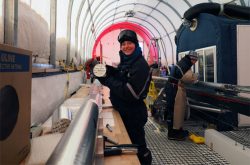
The South Pole and the rest of East Antarctica is cold now and was even more frigid during the most recent ice age around 20,000 years ago — but not quite as cold as previously believed.
University of Washington glaciologists are co-authors on two papers that analyzed Antarctic ice cores to understand the continent’s air temperatures during the most recent glacial period. The results help understand how the region behaves during a major climate transition.
In one paper, an international team of researchers, including three at the UW, analyzed seven ice cores from across West and East Antarctica. The results published June 3 in Science show warmer ice age temperatures in the eastern part of the continent.
The team included authors from the U.S., Japan, the U.K., France, Switzerland, Denmark, Italy, South Korea and Russia.
“The international collaboration was critical to answering this question because it involved so many different measurements and methods from ice cores all across Antarctica,” said second author T.J. Fudge, a UW assistant research professor of Earth and space sciences.
Antarctica, the coldest place on Earth today, was even colder during the last ice age. For decades, the leading science suggested ice age temperatures in Antarctica were on average as much as 9 degrees Celsius cooler than the modern era. By comparison, temperatures globally at that time averaged 5 to 6 degrees cooler than today.
The findings are important because they better match results of global climate models, supporting the models’ ability to reproduce major shifts in the Earth’s climate.
Another paper, accepted in June in the Journal of Geophysical Research: Atmospheres and led by the UW, focuses on data from the recently completed South Pole ice core, which finished drilling in 2016. The Science paper also incorporates these results.
“With its distinct high and dry climate, East Antarctica was certainty colder than West Antarctica, but the key question was: How much did the temperature change in each region as the climate warmed?” said lead author Emma Kahle, who recently completed a UW doctorate in Earth and space sciences.
That paper, focusing on the South Pole ice core, found that ice age temperatures at the southern pole, near the Antarctic continental divide, were about 6.7 degree Celsius colder than today. The Science paper finds that across East Antarctica, ice age temperatures were on average 6.1 degrees Celsius colder than today, showing that the South Pole is representative of the region.
Read more at UW News »
